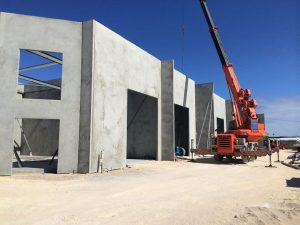
20 Nov, 2014
At RapidTilt we are often asked about the process and the benefits of using the tilt-up concrete method of construction.
The tilt-up construction method is highly innovative, yet in its earliest form it has been used for well-over a century, according to the Tilt-Up Concrete Association (TCA).
Since its beginning the tilt-up process has been refined to ensure that it is strong, durable, cost-effective and time-effective, all of which contribute to its popularity as a preferred method of construction in many countries.
Tilt-up concrete construction employs an innovative method of building. During a project, the walls of the building are poured horizontally on large concrete slabs, called tilt-up wall panels. This work is done on-site, maximising build efficiency and speed.
The next stage is where tilt-up gets its name; the walls are then tilted into their final position using high capacity cranes, creating the exterior walls.

With features of value, speed, and longevity the tilt-up method is meeting the demand for affordable and high-quality builds.
An interesting article from the TCA explores the benefits of this method in great depth.
Savings- Tilt-up is a low-cost method of construction, which offers fantastic saving opportunities to any property developer. The efficient technique results in a reduced need for labour and equipment, while the overall quality and flexibility of the build makes it a highly attractive option.
Durable material- Tilt-up utilises concrete, an incredibly durable material which actually continues to gain strength over time and is also fire resistant. Concrete surfaces are also resistant to damage and can be easily maintained. Tilt-up panels are highly secure and offer excellent benefits for the safety of your property.
Speed of delivery- One of the greatest benefits of tilt-up concrete construction is the speed of project completion. The on-site construction of the wall panels results in time saving benefits. This method allows for the compression of certain stages of construction, with many phases completed simultaneously.
The project time-frame can be accurately scheduled and the technique allows for delivery that is on time.
Design Flexibility- The tilt-up method allows for excellent design flexibility, with modern techniques making it suitable for various projects. The overall finish and aesthetics can be customised to create an attractive finished build.
Safety- The majority of work is done on the ground, in a stable environment which reduces the risk of accidents for the construction team.
As a modern, economical and efficient construction technique, tilt-up passes on many benefits to both the owner and building team, accounting for its growing use and making it the preferred method of construction for many projects.
Additional information and resources around tilt-up construction are available on the Tilt-Up Concrete Association website or contact us at RapidTilt for professional advice.